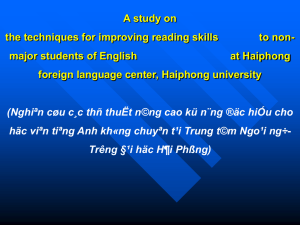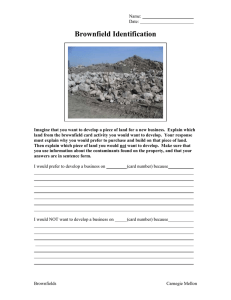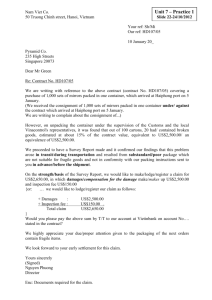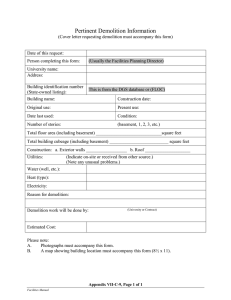Facade retention
advertisement
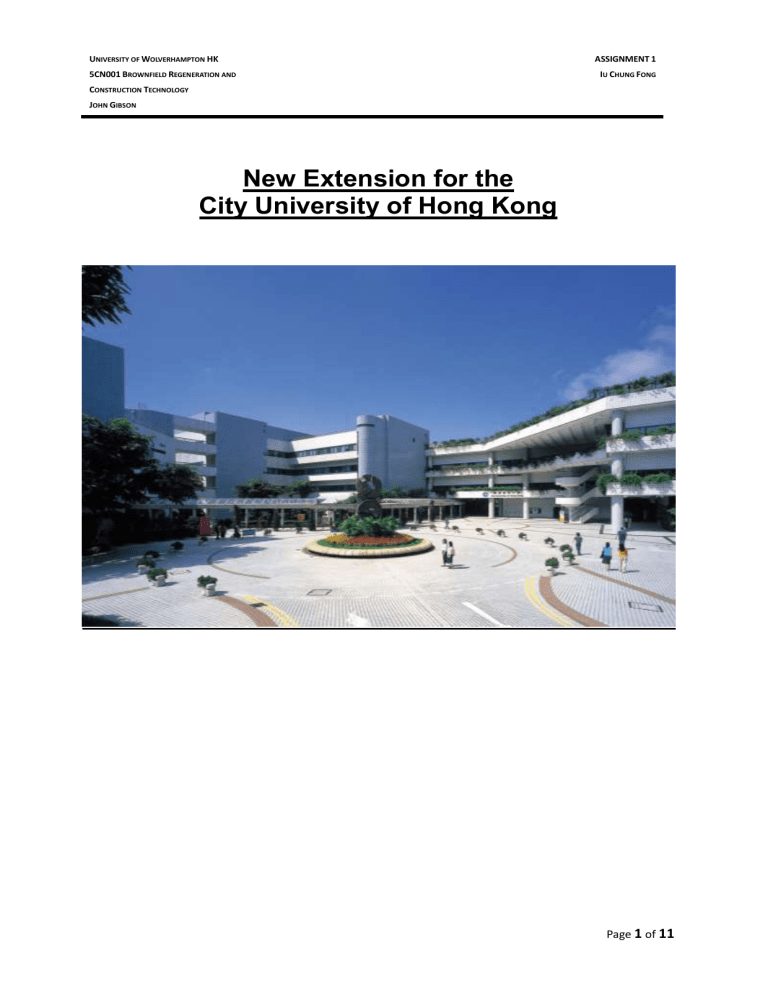
UNIVERSITY OF WOLVERHAMPTON HK 5CN001 BROWNFIELD REGENERATION AND ASSIGNMENT 1 IU CHUNG FONG CONSTRUCTION TECHNOLOGY JOHN GIBSON New Extension for the City University of Hong Kong Page 1 of 11 UNIVERSITY OF WOLVERHAMPTON HK ASSIGNMENT 1 5CN001 BROWNFIELD REGENERATION AND IU CHUNG FONG CONSTRUCTION TECHNOLOGY JOHN GIBSON Table of Contents 1.0 Introduction 1.1 Site Location 2.0 Demolition considerations 2.1 Method and justification 2.2 Plant and equipment involved 2.3 Healthy – Workers and Public 2.4 Safety - Construction site & public 2.5 Consideration factors for demolition techniques 3.0 Facade retention 3.1 Temporary support method 3.2 Attachment method 3.3 Justification 4.0 Foundation 4.1 Ground investigation 4.2 Consideration of surroundings 4.3 MTR 4.4 Adjoining Building 4.5 Monitor noise and movement 5.0 Structural frame 5.1 Choice and justification (R.C or Steel or composite structure) 5.2 Management of deliveries 6.0 Internal Wall and ceilings 6.1 Choice 6.2 Services 7.0 External wall and facade Page 2 of 11 UNIVERSITY OF WOLVERHAMPTON HK 5CN001 BROWNFIELD REGENERATION AND ASSIGNMENT 1 IU CHUNG FONG CONSTRUCTION TECHNOLOGY JOHN GIBSON 7.1 Curtain wall system 7.2 Integration with existing facade 8.0 Floor and Roof Structure 8.1 Consideration of Floor Structure 8.2 Choice of Floor Structure 8.3 Consideration of Roof Structure 8.4 Choice of Roof Structure 9.0 External Wall Enclosure 9.1 Consideration 9.2 Choice of External Wall Enclosure 10.0 Preliminary Design and Analysis 10.1 Preliminary Design 10.2 Analysis (supporting data) 10.3 Reason of site chosen 11.0 Buildability Assessment 12.0 Conclusion 13.0 Reference 1.0 Introduction City University as a modern, international university, Making a Difference through Excellence in Research and Professional Education.Therefore, In the future City University need to put more resource to maintain the high quality education. As required by the City University of Hong Kong, the Daily House, Po Fung and Zhougda Buildings on the Haiphong Road in Tsim Sha Tsui will be the new extension for the City University of Hong Kong. In the future those buildings on Haiphong Road will be demolished and redeveloped, for the new teaching facilities, administrative offices and Student Union recreation facilities. The aims of the new building on the Haiphong Road is to provide diversification space for students and staff can relax and study. Page 3 of 11 UNIVERSITY OF WOLVERHAMPTON HK 5CN001 BROWNFIELD REGENERATION AND ASSIGNMENT 1 IU CHUNG FONG CONSTRUCTION TECHNOLOGY JOHN GIBSON However, According to the HK planning department have stated that Haiphong Road is of historic significance, therefore the new development on the Haiphong Road, we need to maintain the Facades in Haiphong Road. The project should be considered Retainable and reconfigurable. For the design of the new building should be multi-faceted consideration, such as demolition method, choice of foundation, floor and Roof type. Also time and quality need to be consider. So in this report, will percent a new campus that can provide 1.1 Site Location The Daily House, Po Fung and Zhougda Buildings on the Haiphong Road in Tsim Sha Tsui Page 4 of 11 UNIVERSITY OF WOLVERHAMPTON HK 5CN001 BROWNFIELD REGENERATION AND ASSIGNMENT 1 IU CHUNG FONG CONSTRUCTION TECHNOLOGY JOHN GIBSON Site Area : ~85.9 m2 2.0 Demolition considerations 2.1 Method and justification 2.2 Plant and equipment involved 2.3 Protection – Public and Method During the construction many hazards have the potential to injure members of the public and visitor, such as failing objects, delivery and other site vehicles, scaffolding and other access equipment, storing and stacking materials, openings and excavations, ect. To avoid those hazards to the public, we need to secure construction area adequately when finishing work for the day, cover all over excavations and pits, Isolate and immobilize vehicles and plant, set up catch fan in the construction building, also need to store the building materials to avoid the connect to the public. 2.4 Healthy – Workers As the demolition of those buildings, we need to consider health for the workers and public. Packed with tourists and locals, Haiphong Road is known for its heavy traffic. Based on the age of those three building. During the demolition, construction area may flooded hazardous materials, Therefore, will employed specialist before the demolition start to censor the buildings and remove the asbestos containing material. And the site area in Haiphong Road need to provide Page 5 of 11 UNIVERSITY OF WOLVERHAMPTON HK 5CN001 BROWNFIELD REGENERATION AND ASSIGNMENT 1 IU CHUNG FONG CONSTRUCTION TECHNOLOGY JOHN GIBSON adequate ventilation, Also need to provide suitable breathing apparatus for the workers. 2.5 Safety - Construction site & public During the demolition, the site area will full of construction materials, tools, mechanical, that will affect the public. Therefore, The footpath around the site area in Haiphong Road need to be temporary blocked. And the healthy of the workers , Workers working on site need to wear helmet and mask, and they need to wear safety belt for working over 2m form ground. 2.6 Consideration factors and demolition techniques For the demolition work, it required a lot of mechanical equipment. As consider the space of the Haiphong Road is limited. Therefore, top-down method by machines is the choice of the demolition techniques method. This method need to do floor by floor, the aims to insure the stability for the demolition. As the Haiphong road is high traffic flow road in Tsim Sha Tsui , in order to reduce the effect to the public use, the method can lower the demolition time. Also this method is simple to repeat the same procedure to finish the demolition works, that can standardization working process. 3.0 Facade retention The new building in the Haiphong road need to connect to the existing building’s façade, therefore, base on the existing building height, site area size, we need a temporary support method to do the façade retention 3.1 Temporary support method Base on the new building will be the similar height with existing building, and will connect to the façade. Therefore, Horizontal bracing will be the temporary support for the façade. This is the most common form of retention system, beams or trusses running horizontally along the elevation, braced by tower sections. Page 6 of 11 UNIVERSITY OF WOLVERHAMPTON HK 5CN001 BROWNFIELD REGENERATION AND ASSIGNMENT 1 IU CHUNG FONG CONSTRUCTION TECHNOLOGY JOHN GIBSON A horizontal bracing system is needed at each floor level, to transfer horizontal forces to the planes of vertical bracing that provide resistance to horizontal forces. 3.2 Attachment method 3.3 Justify the method As the existing building is 4.0 Foundation The foundations of the building transfer the weight of the building to the ground. Base on our site area located in the high flowing area, and the design of the future building, there will be a few factors should be consider. The choice of the foundation for the new building will following the building structure, ground condition and Topographic, Environmental Impact to vicinity of building. 4.1 Ground investigation As the future building Heights on the Haiphong road will not more than 10 floor, also for the site soil investigation demonstrate the land condition of the Haiphong Page 7 of 11 UNIVERSITY OF WOLVERHAMPTON HK 5CN001 BROWNFIELD REGENERATION AND ASSIGNMENT 1 IU CHUNG FONG CONSTRUCTION TECHNOLOGY JOHN GIBSON road is strong soil. Therefore Shallow foundation will be the future building foundation. 4.2 Consideration of surroundings Those three target building on the Haiphong road is very closed to the Kowloon Park, three buildings is face to the Kowloon Park, therefore the construction need to decrease the effect or damage to the surroundings. 4.3 MTR Site area located in Tsim Sha Tsui, and near by the Tsim Sha Tsui MTR station, the underground already developed by MTR , So our choice of the foundation effected form this factor , the foundation cannot built too deep into underground. 4.4 Adjoining Building Base on the map showing. including our target building, there are five buildings on the same road, and the one next to is separate, the other one were build side by side. Consider impact on adjoining building, In order to project the building near to Po Fung building, during the construction will provide stiffening frame to retain the building. 4.5 Monitor noise and movement During the construction period. We need to maintain the noise and movement in standard range. So there will be a few sound and monitor in site to monitor the extent of the site. 4.6 Conclusion To fulfill the requirements of foundation needs, raft foundation will be the most suitable for this site condition. The technique details of the raft foundation shows on Appendix X. This method will generate less vibration and noise implication to Page 8 of 11 UNIVERSITY OF WOLVERHAMPTON HK 5CN001 BROWNFIELD REGENERATION AND ASSIGNMENT 1 IU CHUNG FONG CONSTRUCTION TECHNOLOGY JOHN GIBSON the vicinity building and environment and more efficiency than other pile foundation. 5.0 Structural frame 5.1 Choice and justification (R.C or Steel or composite structure) 5.2 Management of deliveries 6.0 Internal Wall and ceilings 6.1 Choice 6.2 Services 7.0 External wall and façade 7.1 Curtain wall system 7.2 Integration with existing facade 8.0 Floor and Roof structure 8.1 Consideration of Floor Structure 8.2 Choice of Floor Structure Page 9 of 11 UNIVERSITY OF WOLVERHAMPTON HK 5CN001 BROWNFIELD REGENERATION AND ASSIGNMENT 1 IU CHUNG FONG CONSTRUCTION TECHNOLOGY JOHN GIBSON 8.3 Consideration of Roof Structure 8.4 Choice of Roof Structure 8.5 Choice of Floor Structure 8.6 Consideration of Roof Structure 8.7 Choice of Roof Structure 9.0 External Wall Enclosure 9.1 Consideration 9.2 Choice of External Wall Enclosure 10.0 Preliminary Design and Analysis 10.1 Preliminary Design 10.2 Analysis (supporting data) 10.3 Reason of site chosen 11.0 Page 10 of 11 UNIVERSITY OF WOLVERHAMPTON HK ASSIGNMENT 1 5CN001 BROWNFIELD REGENERATION AND IU CHUNG FONG CONSTRUCTION TECHNOLOGY JOHN GIBSON 12.0 Conclusion [content] 13.0 Reference [content] -End of Report- Page 11 of 11
